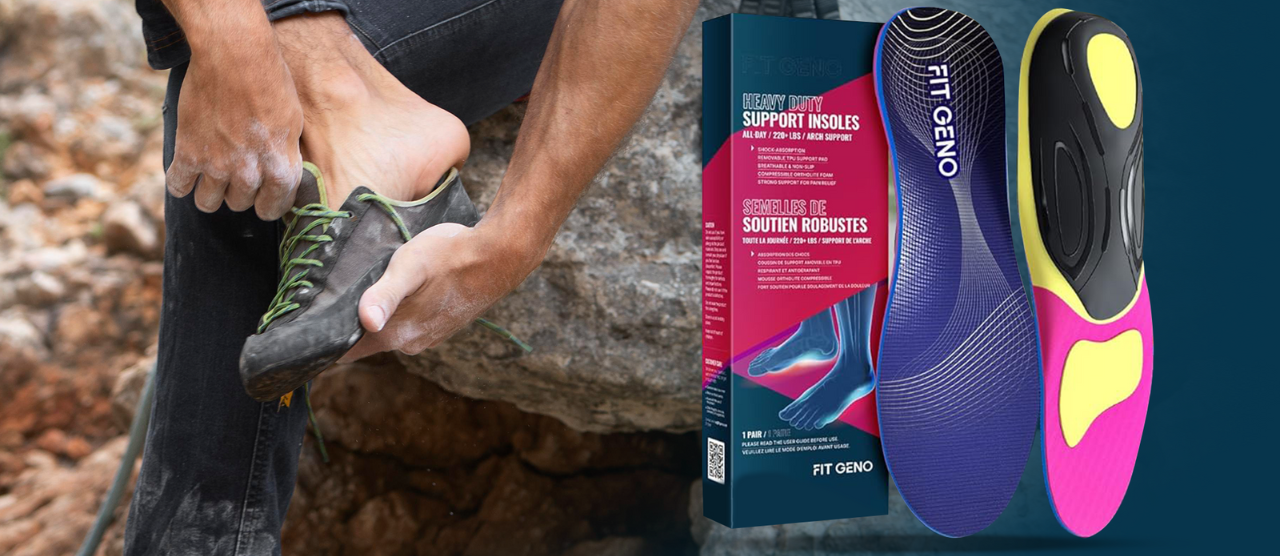
Understanding Arch Support: What Is It and Why Do You Need It?
August 02, 2024 4 min read
Arch support is an essential element in footwear that plays a significant role in supporting the natural arches of the feet. Whether you have high arches, flat feet, or a neutral arch, understanding the importance of proper arch support can greatly impact your foot health and overall well-being. Let's start to know arch support by knowing its brief history.
Did you know that:
The first known orthotic foot devices date back almost 2,000 years! Layers of wool were inserted into sandals to relieve foot strain and fatigue, giving the wearer, who almost certainly spent most of the day on his or her feet--a bit of extra cushioning. The first recorded use of arch support occurred in 1865, when Everett H. Dunbar of Bridgewater, Massachusetts, inserted leather “lifts” between the insole and the outsole of his shoe, giving extra support to the arch.

(Photo credits to biotechpossibilities.com)
The Whitman Brace, which debuted in 1905, is considered the first true foot orthotic and was introduced to the world by Boston orthopedist Royal Whitman. The device, a stiff metal arch support flanged around the heel and the arch, was popular among orthopedic surgeons because of Whitman’s reputation in the field -- even though it was bulky, heavy, and distorted the wearer’s shoe.
In 1910, Dr. William Scholl (yes, that Dr. Scholl) came out with a much lighter, more flexible metal support called the Foot-Easer. As you may have guessed, millions of pairs sold over the next several years.
Having known these details in the history of arch support suggests that people have been using this device for quite a long time for common reasons, such as supporting the arch of your foot in order to reduce pain, and relieving foot strain and fatigue.
In this article, we'll delve more into what arch support entails, why it's essential, and how it benefits your feet.
What is Arch Support and its role towards the Arches of the Foot?
Arch support refers to the structure or mechanism within footwear that helps maintain the natural arches of the feet. The arches of the foot are essential as they:

-
Help in proportional body weight distribution to weight-bearing areas.
-
Act as a segmented lever. Which helps in forwarding propulsion of the body in walking, running, and jumping.
-
Act as a shock absorber in stepping & jumping movements.
-
Act as springboard.
-
Adapt the foot to an uneven surface.
-
Protect plantar vessels and nerves.
-
Support the overall alignment of the body.
The arched foot is dynamic and pliable. When the foot is on the ground, the arches flatten somewhat. When the foot is off the ground, arches restore their contour.
The Three Main Types of Arches
-
High Arches: These arches are naturally more elevated and may benefit from arch support that helps cushion and distribute pressure evenly across the foot.
-
Flat Feet: Flat feet have minimal arches or no arch at all, and adequate support can help reduce strain on the feet, ankles, and knees by providing stability and alignment.
-
Neutral Arches: Neutral arches maintain a moderate curve that naturally supports the body's weight distribution. Proper arch support enhances comfort and prevents excessive pronation or supination (rolling inward or outward).
Why Do You Need Arch Support?

-
Preventing Foot Pain: Insufficient arch support can lead to conditions such as plantar fasciitis, heel spurs, and arch pain (or arch strain), especially during prolonged standing or walking.
-
Improving Posture: Properly supported arches help maintain correct alignment of the ankles, knees, hips, and spine, contributing to better overall posture and reducing the risk of back pain.
-
Enhancing Comfort: Arch support cushions the foot and reduces pressure points, enhancing comfort during daily activities and athletic pursuits.
-
Supporting Foot Structure: For individuals with high arches or flat feet, specially designed arch support can compensate for anatomical variations and provide stability.
-
Preventing Injuries: Adequate arch support helps distribute weight evenly, reducing the risk of injuries such as sprains, strains, and stress fractures caused by improper foot alignment.
How to Find the Right Arch Support
-
Know Your Foot Type: Determine if you have high arches, flat feet, or neutral arches to choose the appropriate arch support that matches your foot's natural shape and needs.
-
Choose Quality Footwear: Select shoes that provide built-in arch support or can accommodate orthotic inserts designed for your specific foot type.
-
Consider Buying Superior Arch Support or Orthotics: Quality arch support is often easy to find online at inexpensive costs, but if it's really necessary, you can also consider buying custom-made orthotic inserts prescribed by a podiatrist or orthopedic specialist. These devices also provide tailored support for optimal foot health and function.
-
Evaluate Comfort and Fit: Ensure that your footwear and arch support feel comfortable, provide adequate cushioning, and do not cause discomfort or pressure points.

Understanding the significance of arch support is crucial for maintaining foot health and overall mobility. Whether you're walking, running, or standing for extended periods, proper arch support plays a vital role in preventing pain, enhancing comfort, and supporting your body's alignment. By choosing footwear and orthotic solutions that cater to your specific foot type and needs, you can enjoy improved posture, reduced risk of injury, and enhanced overall well-being. Prioritize your foot health today by embracing the benefits of adequate arch support. It's a step towards happier, healthier feet for years to come.

